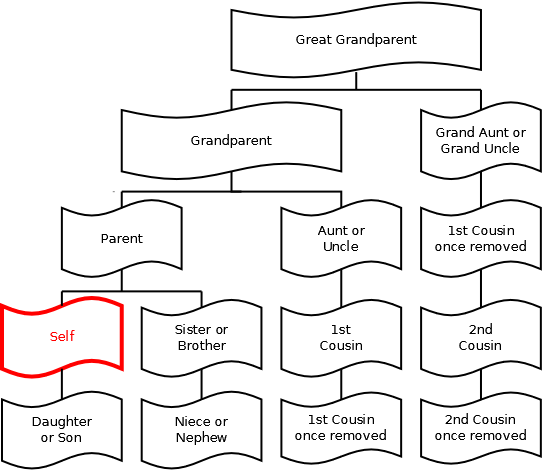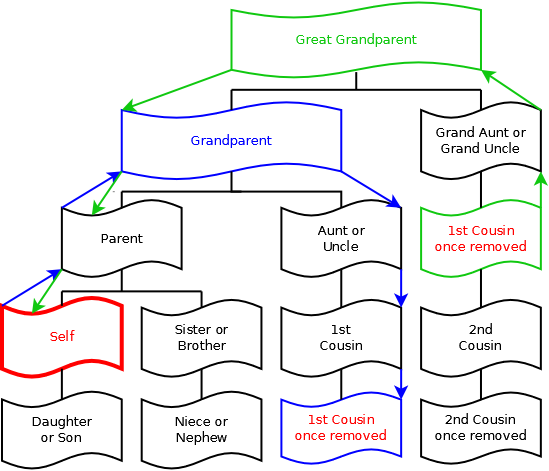Genealogy is a study of relationships, but sometimes it can be hard to keep track of exactly what the different relationship terms really mean.
Obviously, the most basic relationship is that between a parent and child. Every child has parents, even if they do not yet know who they are. When we trace from a child to their parents to their parents to their parents, we have a family tree. But it would be a very rare tree if none of those people had any brothers or sisters.
The brothers and sisters of your parents are your aunts and uncles. At family reunions and Thanksgiving dinners, we usually call the husbands and wives of those people our aunts and uncles too, but in genealogy, they are called the husbands and wives of our aunts and uncles.
The brothers and sisters of your grandparents are your grandaunts and uncles. “So who is my great aunt?” I hear you ask. Most people I have met call their grand aunts and uncles great aunts and uncles. I personally use this term and do not believe it to be incorrect. In all cases, great is used to refer to any additional generation between the related people, but grand is used specifically to reference the first additional generation. So great is not wrong, but grand is more precise and is the answer your genealogy program will give.
Children of our aunts and uncles are our first cousins and they share the same set of grandparents with us. Generally, we just call them cousins, but it is helpful to know the formal term as it more precise and sets the pattern for our second and third cousins. All of our 1st cousins, 2nd cousins, 3rd cousins, 4th cousins, etc. share the same generation level that we do.

This is probably a good time to discuss generations. In genealogy, a generation simply means the next level of ancestors (or descendants). Another way to describe this would be that a generation is one level up or down a family tree. The diagram above shows five generations.

As you can see in the diagram above, you cannot have 2nd cousins without 1st cousins once removed and this is where the confusion usually begins. Once removed simple means one generational level different. Most people have no problem in understanding that the child of their 1st cousin is their 1st cousin once removed – on the diagram we move across to 1st cousin and then one level down to 1st cousin once removed. But look at the relationship above the 2nd cousin, there we have another 1st cousin once removed and it doesn’t appear to make sense – if I move across to 2nd cousin and then up one level, why are they not my 2nd cousin once removed? That is a very good question and the short answer is that although the diagram is a simple way to show the relationships, it does not explain them.
You can’t get there from here.
You have probably already noticed that there are no connecting lines between self and sister or brother – there are no lines going across the generation levels at all. To reach your brother or sister you follow the lines (the bloodlines), you step up to your parents and then back down to your sibling because you are related to your siblings through your parents. To get to your 1st cousin you go up through your parents to your grandparents and then back down through your aunt or uncle to your 1st cousins because you are related to your 1st cousin through your grandparents. That is, the first ancestors that you share with your siblings are your parents and the first ancestors that you share with your 1st cousins are your grandparents. We call these first ancestors “common ancestors” as they are the ancestors you and another relative have in common.
The next thing to remember is that cousin relationships are unique in that they are the same both ways. You are a child to your parents, a niece or nephew to your aunts and uncles and, a grandchild to your grandparents, but you are a cousin to your cousins. You knew that, but you may not have realized that it helps to explain cousin relationships. One more thing to remember is that because cousin relationships are the same both ways, we name them for the cousin closest to the ancestor.

In this diagram your 1st cousins once removed and the common ancestors for each are marked green and blue. You are on a closer generational level to your grandparents than your blue 1st cousin once removed who shares these common ancestors. This relationship is named for your position on the chart.
For your green 1st cousins once removed, you are on a generation level further from your great-grandparents and the relationship is named for that cousin.
At this point, you are either completely confused or beginning to make sense of things. it may help to remember that 1st cousins share grandparents, 2nd cousins share great-grandparents, 3rd cousins share gt-gt-grandparents, and so on. It may also help to notice that there is 1 G in grandparents, 2 G’s in great-grandparents, and 3 G’s in gt-gt-grandparents. With this in mind, you will automatically know that your 5th cousin 6x removed shares a common ancestor with you that is the gt-gt-gt-gt-grandparent to one of you and the gt-gt-gt-gt-gt-gt-gt-gt-gt-gt-grandparent to the other. Automatically? Yes. 5th cousin means one of you is the great-great-great-great-grandchild (5 G’s if you follow the pattern) of the common ancestor and 6x removed means 6 more generations away. It is also quite likely that one of you is dead.
This also works when you know how you each relate to the common ancestor, but not how you relate to each other. If you are the great-great-great-grandchild of a person and you meet a great-great-great-great-great-grandchild of the same person, that person is your 4th cousin twice removed (6 G’s – 4 G’s = 2 G’s).




An absolutely brilliant explanation of cousin relationship terminology. After my husband’s recent family reunion, I am now able to correctly explain to my children how these newly discovered cousins are related to them
This is *exactly* the kind of visual I wanted to see. Thank you, thank you, thank you!
the words of explanation only make me confused with all the numbers – but both the chart with coloured lines is brilliant!
Filling in a copy of the last chart for an extended family is the only way that I will ever be able to understand (or explain to others) a complicated distant cousin relationship!
Very useful information but still quite a lot to get your mind around after 2nd cousins going onto to 4th etc.
Very well explained, color codes were very helpful.